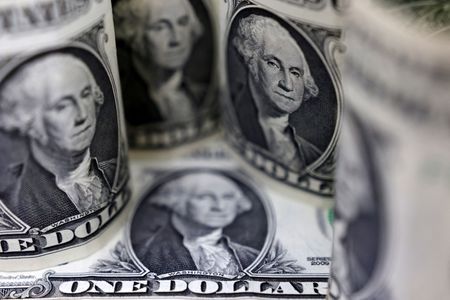By Lawrence Delevingne
(Reuters) – Investors added another cycle of selling on Thursday as the dollar barely eased its stranglehold on currency markets, recession fears sapped stocks and bonds suffered more interest rate pain.
After a partial rebound on Wednesday, U.S. stocks fell sharply. The Dow Jones Industrial Average fell 1.5%, the S&P 500 lost 2.1% to a new low for 2022, and the Nasdaq Composite dropped 2.8%, weighed down by big technology names such as Apple Inc and Amazon.com Inc. [.N]
European stocks also suffered. The STOXX 600 share index was down 1.67%, even as the euro and the pound, hammered over the last week by UK debt concerns, recovered some ground, gaining 0.6% and 1.7%, respectively. [.EU][/FRX]
China currency intervention talk was gathering momentum too, while Europe’s government bond markets were braced for the highest German inflation reading since the 1950s.
Gilt selling also resumed a day after the Bank of England had dramatically intervened to try and quell the storm surrounding the British government’s new spending plans. [GVD/EUR]
“It’s a pick-your-poison collection of bad news for investors,” Sean Sun, portfolio manager at Thornburg Investment Management in Santa Fe, New Mexico, said in an email.
“From strong jobs data pushing the Fed to be more hawkish to the turmoil in the entire UK stock and bond markets to China intervening to prop up the yuan, with increasing geopolitical issues investors are left few places to hang their hats.”
UK SEEKS STABILITY
The UK 10-year gilt yield, which drives Britain’s borrowing costs, rose about 8 basis points (bps) to 4.214% after falling almost 50 bps the day before due to the BoE’s sudden intervention, although the 30-year yield being targeted by the central bank was little changed at 3.96%.
Agnes Belaisch, Barings Investment Institute’s chief European strategist, said “the market wouldn’t mind some stability,” as “it has become a little bit unpredictable.”
She said investors were now seeing “incoherence” in Britain with government spending as the Bank of England tries to rein in inflation, while everywhere else the focus is on how high central banks are prepared to go with interest rates.
British Prime Minister Liz Truss defended her new economic program that has sent sterling to a record low this week and left the UK’s borrowing costs close to Greece’s – saying it was designed to tackle the difficult situation Britain was now in.
“We are facing difficult economic times,” Truss, who only took over as prime minister this month, said on local BBC radio. “I don’t deny this. This is a global problem. But what is absolutely right is the UK government has stepped in and acted.”
The CBOE VIX Index, a measure of Wall Street’s volatility expectations, jumped 6.5%, although still off levels earlier in the week.
Graphics: UK 30-year bond yields see record moves after BoE intervention – https://graphics.reuters.com/BRITAIN-ECONOMY/znvneybqopl/chart.png
GETTING INFLATION IN CHECK
Zooming back out, it was still about the dollar which has crushed currencies virtually everywhere this year, as well as the impact of Russia’s invasion of Ukraine.
Speaking with reporters in London on Wednesday, veteran Federal Reserve policymaker Charles Evans gave no indication that any of the recent foreign exchange and bond market drama would blow the U.S. central bank off its rate hike course.
“We just really need to get inflation in check,” Evans said, backing lifting the Fed’s rates – now at 3% to 3.25% – to a range of 4.5% to 4.75% by the end of the year or March.
Federal Reserve Bank of Cleveland President Loretta Mester echoed that on Thursday, saying she did not see distress in U.S. financial markets that would alter the Fed’s campaign.
Such comments helped push the yield on U.S. government bonds. The yield on 10-year Treasury notes was up 6.5 basis points to 3.772%; 30-year Treasury bonds rose 2.9 basis points to 3.710%.
Thursday’s currency moves saw the U.S. dollar index, which measures the currency against its peers, hang around its recent 20-year high again, down about 0.4%, having had its worst session in 2-1/2 years on Wednesday. [/FRX]
“Despite substantial appreciation year-to-date, we see little pressure for policymakers to respond to dollar strength for now,” Morgan Stanley strategists wrote in a note released Thursday.
“Trade-weighted dollar strength is not excessive, in sync with broadly tighter financial conditions and in line with Fed objectives, though inflation benefits are small.”
Overnight, China’s yuan had fallen again too, although it stayed just off recent post-financial crisis lows, as China’s central bank said stabilising the foreign exchange market was its top priority and on reports of potential FX intervention too. [CNY/]
MSCI’s broadest index of Asia-Pacific shares outside Japan ended the day virtually flat, although Japan’s Nikkei did manage a near 1% rise. [.T]
Weekly jobless claims data bucked expectations with an unexpected fall showing how tight the U.S. labour market remains. U.S. GDP fell at an unrevised 0.6% annualised rate last quarter, the government said in its third estimate of GDP. The economy contracted at a 1.6% rate in the first quarter.
Oil prices were ticked down, still weighed on by the stronger dollar and weak economic outlook, even as OPEC+ have begun discussions about an oil output cut.
U.S. crude fell 1.1% to settle at $81.23 per barrel and Brent ended at $88.49, down 0.9% on the day.
Goldman Sachs cut its 2023 oil price forecast earlier this week, citing expectations of weaker demand and a stronger U.S. dollar, but said global supply issues reinforced its long-term view that prices could rise again.
The strong dollar also helped keep gold prices down, with looming rate hikes also a headwind. Spot gold added 0.1% to $1,660.24 an ounce. U.S. gold futures fell 0.02% to $1,660.00
Graphics: Major currencies vs. the dollar – https://graphics.reuters.com/BRITAIN-MARKETS/jnvweqwekvw/chart.png
(Reporting by Lawrence Delevingne in Boston and Marc Jones in London; Editing by Andrew Heavens, Jonathan Oatis and Marguerita Choy)





